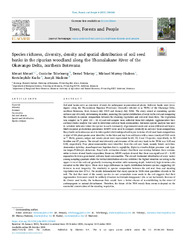| dc.contributor.author | Mmusi, Mmusi | |
| dc.contributor.author | Gaolathe, Tsheboeng | |
| dc.contributor.author | Demel, Teketay | |
| dc.contributor.author | Michael, Murray-Hudson | |
| dc.contributor.author | Keotshephile, Kashe | |
| dc.contributor.author | Joseph, Madome | |
| dc.date.accessioned | 2023-04-12T18:53:55Z | |
| dc.date.available | 2023-04-12T18:53:55Z | |
| dc.date.issued | 2021-10-21 | |
| dc.identifier.citation | Mmusi, M., Tsheboeng, G., Teketay, D., Murray-Hudson, M., Kashe, K., & Madome, J. (2021). Species richness, diversity, density and spatial distribution of soil seed banks in the riparian woodland along the Thamalakane River of the Okavango Delta, northern Botswana. Trees, Forests and People, 6, 100160. | en_US |
| dc.identifier.issn | 26667193 | |
| dc.identifier.uri | 10.1016/j.tfp.2021.100160 | |
| dc.identifier.uri | https://www.sciencedirect.com/journal/trees-forests-and-people/about/aims-and-scope | |
| dc.identifier.uri | https://doaj.org/toc/2666-7193 | |
| dc.identifier.uri | https://hdl.handle.net/13049/672 | |
| dc.description.abstract | Soil seed banks serve as reservoirs of seeds for subsequent regeneration of plants. Soil seed banks were investigated along the Thamalakane Riparian Woodlands (hereafter referred to as TRWs) of the Okavango Delta, northern Botswana, from January-July 2015 and January-July 2016. The study aimed at examining species richness and diversity, determining densities, assessing the spatial distribution of seeds in the soil and comparing the similarity in species composition between the standing vegetation and soil seed bank flora. The vegetation was sampled in 71 plots (20 × 50 m) and soil samples were collected from 568 subplots. Agglomerative hierarchical cluster analysis was used to determine soil seed bank communities. Indicator species analysis was used to calculate indicator values for species in each community of germinated seeds and across different soil layers. Multi-response permutation procedures (MRPP) were used to compare similarity in soil seed bank composition. Bray-Curtis ordination was used to infer spatial relationships of soil layers in terms of soil seed bank composition. A total of 109 plant species were identified in the litter and top 9 cm soil layers with a mean density of 2101 seeds m−2. Herbs, grasses, sedges and woody plants were represented by 68, 19, 9 and 13 species, respectively, in 30 families and 87 genera. The overall total diversity and evenness of the soil seed bank in the TRWs was 3.25 and 0.69, respectively. Four plant communities were identified from the soil seed bank, namely Setaria verticilata-Amaranthus hybridus, Acanthospermum hispidum-Setaria sagittifolia, Digitaria eriantha-Eclipta prostrata and Cyperus longus-Fimbristylis dichotoma. Bray-Curtis ordination showed that there was overlap between these communities in terms of seed bank composition. However, MRPP analysis showed that there was significant (P < 0.05) separation between germinated soil seed bank communities. The overall horizontal distribution of seeds varied among sampling quadrats while the vertical distribution of seeds exhibited the highest densities occurring in the upper 3 cm of the soil and gradually decreasing densities with increasing depth. Relatively high densities also occurred in the litter layer. There were large differences in depth distribution between species, suggesting differences in seed longevity. The similarity in species composition between the soil seed flora and standing vegetation was low (27%). The results demonstrated that many species in TRWs store quantities of seeds in the soil. The fact that most of the woody species do not accumulate more seeds in the soil suggests that their regeneration from seeds would be unlikely if mature individuals disappeared (die or are harvested). Because of its diverse seed banks, the herbaceous flora would have a better chance of re-establishing in the event of anthropogenic or natural disturbances. Therefore, the future of the TRW woody flora seems to depend on the successful conservation of the standing vegetation. | en_US |
| dc.language.iso | en | en_US |
| dc.publisher | Elsevier B.V. | en_US |
| dc.relation.ispartofseries | Forests and People;6, 100160 | |
| dc.subject | Diversity | en_US |
| dc.subject | Evenness | en_US |
| dc.subject | Germination | en_US |
| dc.subject | Soil seed density | en_US |
| dc.subject | Spatial seed distribution | en_US |
| dc.subject | Species richness | en_US |
| dc.title | Species richness, diversity, density and spatial distribution of soil seed banks in the riparian woodland along the Thamalakane River of the Okavango Delta, northern Botswana. | en_US |
| dc.type | Article | en_US |

